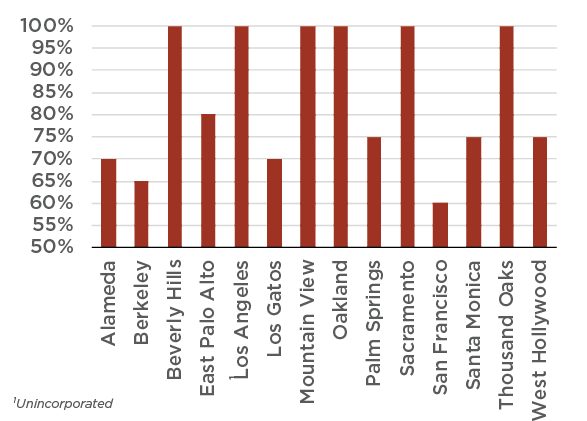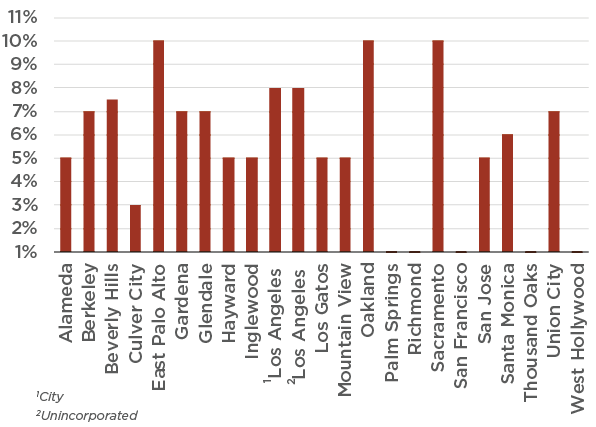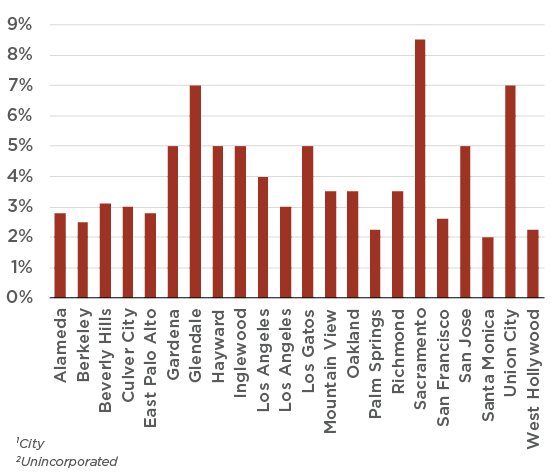Research Insights, October 17, 2019
Rent Control Reckoning or Reasonable Measures?
Based on the headlines, investors could easily get the impression that rent control measures have been passed everywhere and eliminated all possibility for multi-family housing rent increases. The facts are much different and vary significantly from state to state as well as from one city to the next within the same state.
Current Status
The District of Columbia and five states including California, Maryland, New Jersey, New York, and Oregon have implemented rent control statewide. Surprisingly, 33 states not only do not have rent control, they actually preempt it. In addition, 14 states also do not currently have rent control, but also do not explicitly ban it.
.png)
Three key factors determine the impact of rental control:
- Age of buildings the measures apply to
- Annual increase calculation methodology
- Caps on the annual allowable increase
To analyze further the impact of rent control on local real estate, we can take California as an example, both statewide and for those municipalities where rent control measures are in place.
California
California’s statewide rent control law only applies to areas within California not having local rent control measures in place. When municipalities or counties have their own rent control measures, these supersede the statewide measures.
Building Age Minimums
The statewide rent control law applies to buildings 15 years and older. Note that this is on a rolling basis, meaning that a building built 14 years ago is currently exempt from the statewide rent control, but would be subject next year.
Annual Increase Calculation Methodology
The allowable annual increase is the local area annual increase in the Consumer Price Index (CPI) plus 5%.
Cap on Annual Allowable Increase
There is a 10% annual cap on the allowable increase. This both provides protection to tenants from outsized rent increases while allowing for landlords to capture some market rate impact in raising rents.
California Municipalities
At the municipal level there is a significant variation on these three factors across cities.
Building Age Minimums
Cities including Los Angeles, Palm Springs, San Francisco, San Jose, Santa Monica, and West Hollywood have the most restrictive building age parameters with rent control applying only to buildings built before 1979.
At the other end of the spectrum cities including Beverly Hills, Culver City, Inglewood, Mountain View and Sacramento have more expansive age parameters with their rent control measures applying to buildings built before 1995.
Annual Increase Calculation Methodology
While municipalities all generally determine their annual allowable rent increase based on CPI, the percentage of increase used varies substantially across cities. At the low end, San Francisco’s increase is equal to 60% of CPI and Berkeley’s increase is based on 65% of CPI. At the other end of the spectrum, municipalities including Beverly Hills, Oakland, and Sacramento allow for increases equal to 100% of CPI.
There are also variations on the CPI approach. Some municipalities allow for a “greater of” approach. For example, Beverly Hills allows for the greater of 3% or the annual change in CPI while Los Gatos allows for the greater of 5% or 70% of the annual change in CPI.
Other municipalities use a “CPI plus” approach. This involves taking the CPI and adding a predetermined percentage. As an example, Sacramento determines its annual increase based on CPI + 6%. Still other cities like San Jose and Culver City use a flat percentage increase allowed independent of CPI.
Annual Allowable Increase Methodology:
% of CPI

Cap on Annual Allowable Increase
In addition to calculating annual rent increases, the caps placed on annual rent increases, also have significant variations across municipalities.
On the low end, as an example West Hollywood has no caps on annual allowable increases while Glendale only requires landlords to pay tenant moving costs if rent increases are 7% or greater.
Other municipalities like Gardena and Union City do not have caps but allow tenants mediation when rent increases reach certain levels.
Among cities having caps, Culver City is on the low end capping the annual allowable increase at 3% while at the high-end, East Palo Alto, Oakland, and Sacramento allow for up to a 10% annual increase.
Maximum Allowable Annual Increase

Current Year Allowable Increases
In today’s low inflation environment, caps won’t come into play in most cities. There is significant dispersion in the current year allowable increases across markets. At the high end is Sacramento at 8.5% while Santa Monica is at the low end only allowing for a 2% increase.
Current Year Allowable Increase

Conclusion
While rent control related headlines can create a sense that rent control is ubiquitous and uniform, the reality is much more nuanced and less draconian. Current rent control measures generally allow both for tenant protections and reasonable increases. Prudent investors will continue to monitor rent control ordinances and efforts allowing them to separate headlines from reality. While rent control poses an ongoing risk, it also can increase the demand for properties not subject to rent control measures.
